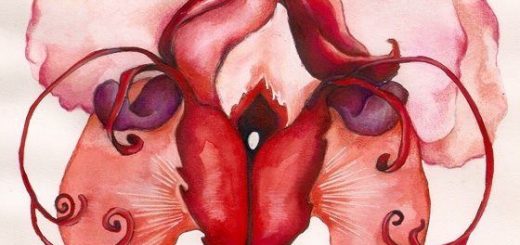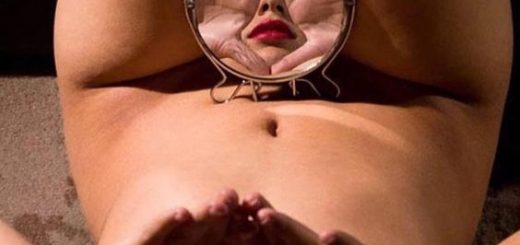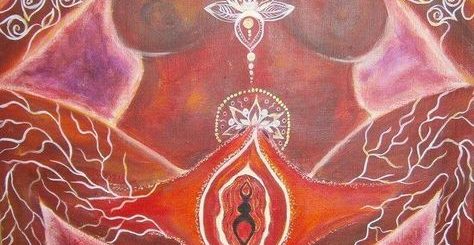Yes, Virginia there is a G-spot… But not every woman has one

Have you read the latest hype about the G-spot lately? On February 20th, the BBC News declared that the “Female G spot can be detected“, citing research published in the Journal of Sexual Medicine, by an Italian doctor, Emmanuele Jannini. During the study, each woman (twenty in all) underwent an ultrasound examination of their “clitoris-urethrovaginal complex, also known as the G-spot” to measure the size and thickness, which according to Jannini, corresponds to whether of not they can achieve “the vaginally activated orgasm” (female ejaculation or gushing). The good news? Yes, Virginia there is a G-spot, but according to Jannini, not every woman has one.
Needless to say, this “discovery” was disconcerting to many sexologists and women alike, including Beverley Whipple and her colleagues who previously proved the existence of the G-spot in over 400 women in 1982, in their groundbreaking book: “The G Spot (And Other Discoveries About Human Sexuality)“. In a subsequent article, “Orgasm and the Spot! The G-Spot!“, Whipple responded, “I would recommend that our Italian colleagues ask the women to masturbate…” The G-spot has remained elusive in the past because “in it’s sexually unstimulated state, it is relatively small and difficult to locate, especially since you can’t see it.” But, that’s only one reason why the G-spot has been misrepresented.
In a paper presented by John D. Perry, PhD in 1984, Perry blames Alfred Kinsey for starting the “Vaginal versus Clitoral debate” which denies (and ignores) the importance of the vagina (and therefore the G-spot) in terms of sexual response: “It is a professional issue for psychologists because for the past 30 years most of us have been telling our patients that there is no such thing as a vaginal orgasm, and as a result, less and less of them are having vaginal orgasms. In terms of the destruction of human pleasure, this may well be the most heinous iatrogenic illness ever perpetrated on western civilization.”
Dr Jannini’s conclusions are just as misleading as Kinsey’s denial of the vaginal response to stimulation. These ideologies are reminiscent of the “wandering womb” syndrome in the late 1800s. During this time, women’s sexuality was seen as a disorder known as hysteria that had to be cured, and women who desired sexual pleasure and orgasm were considered psychologically abnormal. Jannini’s assertion that the G-spot is missing in some women, threatens to cast us back into the dark ages of belief systems that has shrouded female sexuality in myths. This kind of speculation is damaging to women’s right to pleasure, leading to sexual frustration, false cures and self-doubt. When will we emerge from the shadows?
For those who still wander Plato’s dark cave gazing at shadows, be assured that the G-spot does exist and every woman has one. Ask any woman who has experienced female ejaculation and they’ll assure you that G-spots are not a myth (after they hit you over the head with a giant comma-shaped dildo).
Just the Facts Please, Ma’am
The G-spot is “named for the German physician Ernst Grafenberg who first described ‘an erotic zone located on the anterior wall of the vagina along the course of the urethra that would swell during sexual stimulation.'” The area the G-spot inhabits is known as the urethral sponge, a “tissue that wraps around the urethra and swells with fluid during sexual arousal.” It is associated with the prostate gland in men and is made up of a complex system of erectile tissue, secretion glands, the internal pelvic nerve and muscles that “engage with one another during your arousal cycle.” Violet Blue, author of “The Smart Girl’s Guide to the G-Spot” uses this analogy to explain women’s sexual organs: “The area of the clitoris is far larger than described in conventional anatomy texts and most sex guides. The external tip, or glans, is really the tip of the iceberg–and if you know icebergs, they’re like upside-down pyramids…” Women can feel pressure on their G-spot by stopping mid-stream while urinating. The G-spot can also be felt internally, by placing your fingers 1″-2″ inside the vagina and feeling around the front wall, just behind the pelvic bone. There, a wrinkly, prune-like surface will swell with fluid when aroused via firm, deep pressure, thus making itself noticeable to touch.
To some women, the G-spot is an erogenous zone that offers intense sexual pleasure and can lead to female ejaculation. To other women, stimulating the G-spot can feel uncomfortable, or give them the urge to pee, which they may dislike. Most women need to be sexually aroused in order to feel it, and the stimulation needs to be applied with firm pressure. There are many sex toys that have been developed for stimulating the G-spot, including pleasure-enhancing gels that help bring blood to the urethral sponge. Like sexual preferences, every woman’s response to G-spot stimulation is different.
My Experiences
A few years ago, I went to a women’s bathhouse and met a woman known as G-spot Girl. She wore a big “G” inside a red spot on her t-shirt that she had hand-drawn and was “the” self-appointed super-heroin and advocate of G-spots, teaching others how to find and stimulate their own elusive zones. In a scene that was filmed for Showcase’s documentary KINK, G-S Girl showed my friend Suspiria how to find her G-spot in front of an audience of eager females. She instructed Suspiria to feel the inside of her cheek with her tongue, telling her this is what her G-post would feel like. Next, she invited my friend to insert her fingers within G-S Girl’s vagina, and begin rubbing the vaginal wall in a “come-hither” fashion. With a little more coaching and spectator encouragement, Suspiria had G-S Girl spurting female ejaculate across the room in minutes. We were all in awe.
What happened to G-S Girl was the result of a good deal of research, years of self-exploration and masturbation. Most women cannot ejaculate on command. For many women, G-spot ejaculation the first time is often a fluke and comes as a complete surprise.
My first experience happened in my twenties, with a boyfriend who had awakened my body to the pleasures of orgasm. I can remember being intoxicated by sexual pleasure and abandoning myself to those sensations, my pleasure-censoring self-critic silenced in my mind behind a cloud of sensory euphoria. My whole being was focused on the experience of getting fucked, as my spot was rammed by his exquisitely designed cock. I remember feeling a mounting pressure as if I were going to pee, but my mind was so far removed, I ignored it. Then I gushed all over the sheets as intense climax shook through my body in waves and ripples. Neither my boyfriend or I knew what had just happened to me. Inspection of the fluid on the soaked sheets revealed that it was clear, thicker than water, and didn’t smell like urine. I had just experienced a G-spot ejaculation, but it would be many years later before I knew what it was called.
Sexologists Paving the Way
Like many women who have experienced female ejaculation for the first time, my experience was not unusual. I had a deep, full body awakening, with multiple contractions that was unlike a clitoral orgasm. It was not until I learned about Annie Sprinkle, (her porn star name that was coined from her ability to female ejaculate), and began exploring her work on female sexual pleasure that I learned more about female ejaculation. Annie has passionately explored sexuality for thirty six years as a porn star, sex educator and activist, sexuality coach, and role-model for the younger generation. She is an expert on all things sexual, including G-spots and says that “These days, when women ask me if it’s worth learning to ejaculate, I answer that it is. But expect to do extra loads of laundry.”
From Annie, I was turned on to Deborah Sundahl who created the film “How To Female Ejaculate” (1992), where she inserted a speculum sideways to show viewers her urethral sponge. Deborah maintains that some women have difficulty finding their G-spot because “we have been told for over 400 years that the female prostate doesn’t exist; that it is shriveled up and non-functioning. If you are told by every corner of society that something doesn’t exist, you tend to believe it…” She also attributes G-spot numbing to the fact that we as a society don’t take time to explore the pleasures of our bodies or the sexual act as we race towards climax. Women need foreplay and a certain level of arousal for their G-spots to make itself known. Deborah furthermore attributes emotional and sexual abuse to women’s inability “to feel pleasure.”
Here are the facts:
-Every woman has the urethral sponge, or G-spot. Although some women may not enjoy the feeling they get from stimulating it.
-The G-spot can be found with a little bit of exploration and a healthy sense of adventure.
-54-60% (reportedly) of women have experienced emission of fluid at orgasm.
-The clear fluid that is ejaculated by women from the paraurethral ducts and/or urethra during orgasm is believed to originate from the Skene’s gland.
-The chemical make-up of that ejaculate is not urine, but contains high levels of prostatic acid phosphatase, glucose and fructose (all found in the prostate fluid of semen).
So, Yes, Virginia, there is a G-spot and, guess what! You do have one. Don’t believe the hype and myths. Go find yours. Chances are you may like it.
To find out more about the G-spot check out these valuables resources including: Female Ejaculation & The G-Spot by Deborah Sundahl, The Good Vibrations Guide To The G-Spot, Dr. Carol Queen’s G Marks the Spot, Nina Hartley’s Guide To G-Spot Sex, Annie Sprinkle’s Amazing World of Orgasm, and Liquid Love from sex educators Deborah Sundahl and Dr. Carol Queen.
This is a repost from my old blog: CherryBoxxx










4 Responses
[…] 3 of 5 in the series G-spot SeriesThis entry is part 4 of 5 in the series G-spot SeriesG-spot SeriesYes, Virginia there is a G-spot… But not every woman has oneFemale Ejaculation Without Orgasm?Clitoral or G-spot?The G-Spot Girl’s Resource GuideHow to […]
[…] Yes, Virginia there is a G-spot… But not every woman has one […]
[…] Back on Earth, we still encounter the G-spot debate with pseudo-scientists disclaiming its existence. “In an era where we have flown men to the moon, made Star Trek’s communicators a reality, grown ears on the backs of mice and cloned sheep, it seems pretty ridiculous that we still haven’t found that elusive G-spot!”—The Case of the Mysteriously Vanishing G-spot. And, there are still sexologists who prefer to stick to their guns when it comes to their Clitoral hierarchy, by spreading the misinformation that the G-spot is only a “smoke and mirrors” parlor trick.—A Critique of Betty Dodson’s “How to Squirt Video”. Yes, the clitoris is essential to women’s sexual pleasure and without it we would not be able to enjoy the G-spot at all, as the G-spot is believed to be an internal extension of the clitoral structure. Still, denying its existence does every woman a disservice and “threatens to cast us back into the dark ages of belief systems that has shrouded female sexuality in myths. This kind of speculation is damaging to women’s right to pleasure, leading to sexual frustration, false cures and self-doubt.”—Yes, Virginia, There is a G-spot… But Not Every Woman Has One. […]
[…] G-spot Myths […]